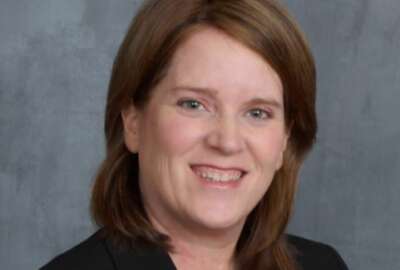Sammies finalist helped design lucrative spectrum auction process for FCC
The electromagnetic spectrum that our phones, radios and TVs rely on is a scare commodity and figuring out how to allocate it in the most sensible way has been a...
Best listening experience is on Chrome, Firefox or Safari. Subscribe to Federal Drive’s daily audio interviews on Apple Podcasts or PodcastOne.
The electromagnetic spectrum that our phones, radios and TVs rely on is a scarce commodity and figuring out how to allocate it in the most sensible way has been a challenge for the past century. The way the Federal Communications Commission does it now, particularly when it comes to cell phones, is based on a complex auction process. The idea is to use market forces to make the most efficient use of the spectrum. Those auctions have generated more than $200 billion in revenue to the federal government so far. Our guest is one of the designers of the modern-day process. Evan Kwerel is a senior economic advisor at the FCC, where he’s spent more than three decades working on the problem. And he’s a finalist for this year’s Service to America Medals. He talked about his work with Federal News Network’s Jared Serbu on Federal Drive with Tom Temin.
Interview transcript:
Evan Kwerel: Prior to auctions, there were two different ways of awarding FCC spectrum licenses. The first way was what was known as comparative hearings, which was the administrative process. And applicants would explain why they were the most deserving of the spectrum. And they were referred to as beauty contests took a long time to get through. And they were pretty arbitrary. Licenses can be awarded based on differences that didn’t matter. With the advent of cellular, it just became untenable to be reviewing all these processes by this administrative procedure. So Congress, in its wisdom, gave the FCC authority to use random selection, or lotteries. So if it was arbitrary, why not just among those licensees that were qualified, why not just select them by a random method. And they used a hot air ping pong ball machine that had been been used in World War II, which was closeted right outside my office. So I got to see the guts of the process with numbered balls. That process also turned out to be highly defective. What you ended up with was people just applying just just to win the license and flip it. And we had like over 400,000 license applications for the least valuable cellular licenses. So many applications that the shells in Gettysburg collapsed under the weight of all the applications. So given that it provided no revenue to the government, and people who had no intention of using the licenses were winning, there was a move to find something better. And I was I was one of the applicants for something better. As soon as I got to the FCC, I started advocating for spectrum auctions as a better means. And I’m not saying that I was the idea originated with me. Ronald Coase, Nobel Prize winner in economics, was the considered the father of spectrum auctions, although he attributes the idea to a law student who wrote a article in the University of Chicago Law Review. So all these things, there are a few new ideas under the sun. But I think I can say that I made a difference in making it a reality and by applying cutting edge economics to it.
Jared Serbu: Yeah, on its face. I mean, an auction sounds simple enough, most of us are familiar with the idea that an item is up for auction and it goes to the highest bidder. It is not simple in the FCC’s case. Can you talk a little bit about some of the interdependencies that actually go into a spectrum auction in modern times?
Evan Kwerel: Well, the sort of traditional auctions, and like the auctions that the government has been using, like for auctioning leases for offshore oil and gas, they do it sequentially, one lot after another. The problem with that is that spectrum licenses are highly interdependent, it matters to the licensee and to the public that you have continuous coverage geographically. Yu don’t want to have areas where there’s no license. And it also matters that the licenses are contiguous in frequency, you get a lot more capacity if you have contiguous licenses. So doing it the traditional way, whether it was a sealed bid, which is what they do for offshore oil and gas, or whether you have an auctioneer, like a cattle auction or tobacco auction, you do it one after another. And the person when they’re bidding on one license has to be guessing whether they’re going to be able to get the other licenses that would be complimentary or substitutes, and so that was not a great idea. As part of the process for implementing auctions, we had to write a notice of proposed rulemaking which says what are the rules that we’re going to use for auctions. And I wrote the policy section. And while I knew that doing things simultaneously, so that you could put together the right combinations in geography and in spectrum, was the right way to do it. And I’d written a working paper in 1985, which said as much. I actually didn’t know how to do it. But fortunately, Paul Milgram and Bob Wilson came up with a better idea. And their idea was simple, but but brilliant, which was that all the licenses should be put up for bid at the same time, and that the auction shouldn’t close until there was no bidding on any of the licenses. The idea had one flaw, which was something which was with the closing roll that it will not end until all licenses the bidding stopped on all licenses, people would would hold back like they often do in eBay, things they snipe or snake in the grass. The problem is that the auction is supposed to be producing information. So bidders will know what the value of the different licenses would be. And it doesn’t produce any information if everybody waits till the last minute. So I raised this question. And Milgram and Wilson came up with this sort of brilliant activity role, which gave bidders incentive to bid throughout the auction, because if they didn’t bid, they were penalized in terms of losing their ability to bid in the future. It may not seem like a big deal, and it wasn’t the only thing that I contributed, because it was a really a collaborative process to get all the details, right. But Milgram and Wilson both said that my contribution to the design of the auction was so great that I actually deserved to be included in the Nobel Prize, which I think was very flattering, and perhaps an overstatement. But the point was that you needed to get all the details right. It wasn’t enough to have this this brilliant design if the auction never ended.
Jared Serbu: And just to pick up on that last piece, it strikes me that that penalty is a really big deal in this context, right, because it’s not just a bunch of random speculators coming in and bidding on these pieces of spectrum, it’s really a relative handful of mobile operators that really can’t afford to not be cut out of the next auction.
Evan Kwerel: Yeah, well, the penalty wasn’t that they were cut out of the next auction, it was within that auction be affordable. Within that auction, you had to put down a certain money based on the the maximum amount that you wanted to bid, the maximum number of bidding units that you wanted to bid on. So each license it was based on the amount of spectrum and the population in in the area. So a license was designated by that. And so you started out with your maximum eligibility, and if you’re bidding dropped below some out, you were limited in the future to bidding on no more than that. So you had to keep bidding aggressively, or else you’d be limited. So it was a it was a subtle but effective incentive within the auction.
Jared Serbu: That makes sense. And then then by packaging these auctions, these chunks of spectrum together so that they make sense so that they do have, as you said, geographic continuity, I suppose what you’re doing there is is creating a package that has the optimal value, not just for bidders, but is putting that spectrum to the highest and best use it possibly can be put to as a public asset. Is that about right?
Evan Kwerel: Yes. You said it better than I could. The only thing that I would add is that, as I said before, it’s not only geography, geography is the thing that we can see. But it’s also in terms of frequency that you wanted, you didn’t want to have one block of spectrum here, another block of spectrum there, because the technology gets more capacity out of the spectrum, if the blocks that you get are contiguous in both frequent in frequency.
Jared Serbu: I guess one of the last things I wonder here is it sounds like you did a fair amount of adaptation back in the early days. What have you learned throughout the process that’s let you refine these auctions more recently, or do you feel like things are pretty well solidified at this point? You’ve got a system that makes sense.
Evan Kwerel: Yeah, I think it’s been a process of constant innovation. But there was some what I would consider minor issues of dead singling. One of the things that we did was we went to anonymous bidding, because we wanted to prevent people from tacit collusion. And when they knew who the other bidders were, it was possible by making bids, and they use the trailing digits, they were able to bid down to the dollar. And so so bidders would put down information in their bid. And since everything was transparent, other bidders could know what was going on, and it seemed possible to collude. So what we did was we went to anonymous bidding, you just see the bids, but you don’t know who’s doing that. That was one of the adaptations, but I think the most revolutionary was in our auctions we also developed a two sided auction, and that actually was an idea that I came up with, which was to allow not only, like the wireless operators to buy spectrum, but the incumbents, in this case broadcasters who had more spectrum than really was appropriate for the public use, to sell their spectrum in the in the same auction. So that was, I think, it was a revolutionary change in spectrum policy, because traditionally, it’s an administrative process that determines how much spectrum would be reallocated from a less valuable to a more valuable use with with the broadcast incentive auctions. It was a two sided auction, where we used markets to determine how much spectrum was going to go to the new higher value use. Which licensees would get it? How much they would get paid for it?
Jared Serbu: Sorry, one last thing, because your point about anonymity raised another thing in my head, which is, I guess, if you weren’t careful about this, you could you could design a spectrum package in a way such that it is more valuable to one incumbent than another. And you would figure out pretty quickly who the bidders are. So it’s part of this, designing a package that is going to be of equal value, no matter who ends up winning the auction.
Evan Kwerel: Okay, there’s always a question of how you divide up the spectrum into licenses. But generally, what we’ve done is to divide it up into relatively small pieces, where the bidders are the ones that that create the packages, both in geography, and in frequency. And because it’s anonymous, nobody knows what the packages are that other people are putting together. When it was perfectly transparent, we had an intermediate step in transparency where we didn’t say who it was, but we would just identify some bidder and you could see which packages people were putting together. And then that was a problem. So we went to complete anonymity. So you should be on our team, you have great questions. It was a big debate from from day one in the auction design. And the manager of the whole process, I had argued for anonymity from from the get go, but the manager concern was, it’s really hard to keep things anonymous in government, and he didn’t want a scandal where it leaked out, somebody knew and somebody else didn’t know. So it just sort of seemed, in terms of good government and avoiding scandal, that we should just make everything open and not have people trying to get the information. But it turned out, it created a problem. So eventually, we got to the anonymous bidding.
Copyright © 2024 Federal News Network. All rights reserved. This website is not intended for users located within the European Economic Area.
Tom Temin is host of the Federal Drive and has been providing insight on federal technology and management issues for more than 30 years.
Follow @tteminWFED






